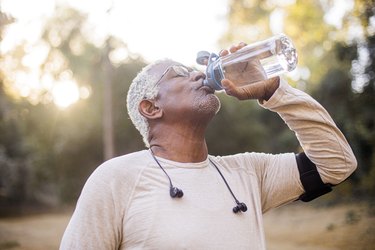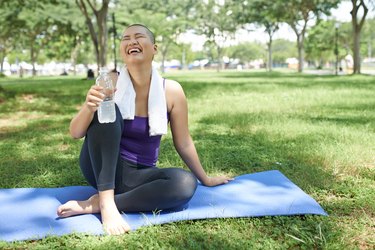
Across social media, cold plunging is having a moment. On Instagram, for example, there are nearly 100,000 results for #coldplunge, bringing up images that range from repurposed chest freezers to holes cut in ice-crusted lakes. People wearing only a swimsuit and a grimace lower themselves into icy water and rhapsodize about the benefits for muscle recovery, heart health and more — despite looking like a grueling moment of Navy SEAL training.
But the real question is: Does cold plunging actually work?
Video of the Day
Video of the Day
The answer seems to be: It depends on how you use it. Here's a look at what cold plunging entails, what the research says and why experts suggest you dip cautiously if you're considering giving it a try.
What Is Cold Plunging?
Just as the name implies, cold plunging involves submerging your body in cold water for a short period of time, usually between 30 seconds to a few minutes, says Robert Segal, MD, board-certified cardiologist and founder of Manhattan Cardiology in New York City.
The water temperature is usually between 50 to 60 degrees Fahrenheit (10 to 15 degrees Celsius). There are specialized cold plunge tubs or pools designed to achieve and maintain that temperature, but some people opt for swimming in naturally cold water — such as a wintry sea, lake or river — or creating their own cold-water immersion pool with a combination of water and ice.
What Are the Benefits of Cold Plunging?
The potential benefits of cold plunging include both mental and physical boosts, Dr. Segal says, and some have more evidence than others.
"We know that exposure to cold, such as immersion in cold water, has been demonstrated to lessen inflammation in the body, which can aid with joint pain and muscle repair," he tells LIVESTRONG.com.
There's also some evidence it could improve mental clarity, Dr. Segal says. That's because endorphins (hormones that reduce your perception of pain and improve your mood) like dopamine (a chemical released in your brain that makes you feel good) are produced at a higher rate after submersion in cold water. That may also help reduce stress and anxiety.
"Other benefits that have been discussed include improved circulation and better immune function," Dr. Segal says. "However, it's important to note that cold plunging could also be dangerous if not done properly."
What Does the Research Say?
Part of the difficulty with determining the efficacy of cold plunging is the limited number of studies that have been done on the practice, says Carol Mack, DPT, CSCS, a physical therapist and strength and conditioning specialist who founded CLE Sports PT & Performance in Cleveland.
"At this point, there is very minimal research to support the benefits of cold plunging," she tells LIVESTRONG.com. "For example, there's one study that many people use to support cold plunging, but that has a very small sample size and the control group wasn't matched well to the plunging participants, so it's hard to draw an accurate comparison and provide a definitive answer."
That study, published October 2021 in Cell Reports, had 15 participants and looked at the effect of winter swimming. The control group had 50 percent more body fat than the swimmers, and the experiment wasn't about the effects of a few cold plunges — those in the swim group did that exercise regularly, about two to three times per week for at least two years.
Risks of Cold Plunging
More of a concern than potential ineffectiveness are the possible negative effects of cold plunging on the cardiovascular system, Dr. Segal says. According to some research, he says, cold plunging can actually raise your risk for certain issues.
The practice has been linked to the following:
- Increased blood pressure: Dr. Segal says the body's natural response to cold water is to constrict blood vessels, which can raise blood pressure. This may put extra strain on the heart, particularly in people with existing cardiovascular conditions.
- Heart arrhythmia trigger: The shock of cold-water immersion can sometimes prompt abnormal heart rhythms, especially in people with pre-existing heart conditions, Dr. Segal says.
- Decreased heart rate: Although blood pressure might rise, heart rate can slow down in some people, Dr. Segal says. This effect, called bradycardia, is generally not harmful but can be dangerous in those with underlying heart conditions.
- Hypothermia: Prolonged exposure to cold water can cause your body's core temperature to drop, leading to hypothermia. That's dangerous for your cardiovascular system because it can lead to heart failure if not addressed immediately.
"It's recommended that individuals consult with a medical professional before trying cold plunging, and start with shorter exposure time to avoid hypothermia and other negative side effects," Dr. Segal says.
Tips to Cold-Plunge Safely
If cold plunging is an activity you think you'd enjoy, feel free to drag that old chest freezer out into the yard, buy a new stock tank at a farm supply store or head out to a chilly body of water near your home. Just be sure to follow this advice to stay safe:
- Get your doctor's approval first: Talk to your doctor if you have a heart condition or any other health issue that might be affected by cold plunging.
- Bring a buddy: This is an additional safety measure, Dr. Segal says, in case you feel any unexpected effects such as weakness or dizziness.
- Warm up slowly: Rewarm your body gradually after you plunge to give your nervous system and heart some time to adjust to the temperature change, Mack says. In other words, don't jump straight from a cold plunge into a hot shower or other hot environment.
Cold-Plunge Alternatives to Consider
There are other strategies that can help with exercise recovery and provide other health benefits, and they often have more evidence behind them, Dr. Segal says.
"One major example is cold showers, which can provide benefits such as increased circulation, improved immune function and reduced inflammation," he says. "Another is cryotherapy, a treatment that involves exposing the body to extreme cold temperatures for a short period."
There are also the tried-and-true cold-therapy devices for targeted treatment, he adds, such as the Hyperice line of products. These include ice packs and cold-therapy machines, along with compression wraps, which all help to reduce inflammation.
Is this an emergency? If you are experiencing serious medical symptoms, please see the National Library of Medicine’s list of signs you need emergency medical attention or call 911.


